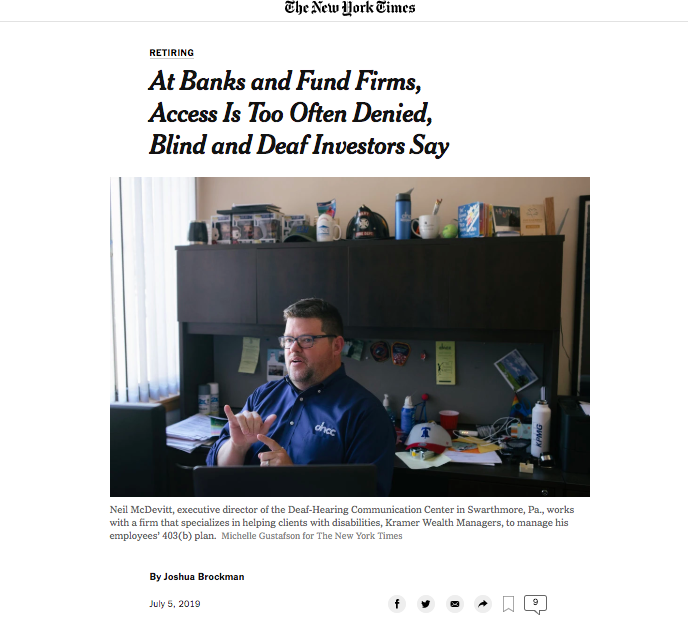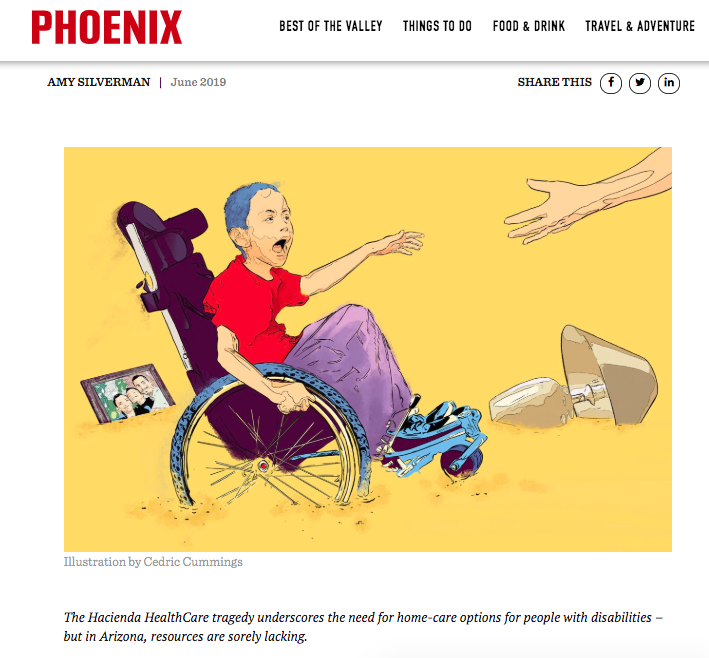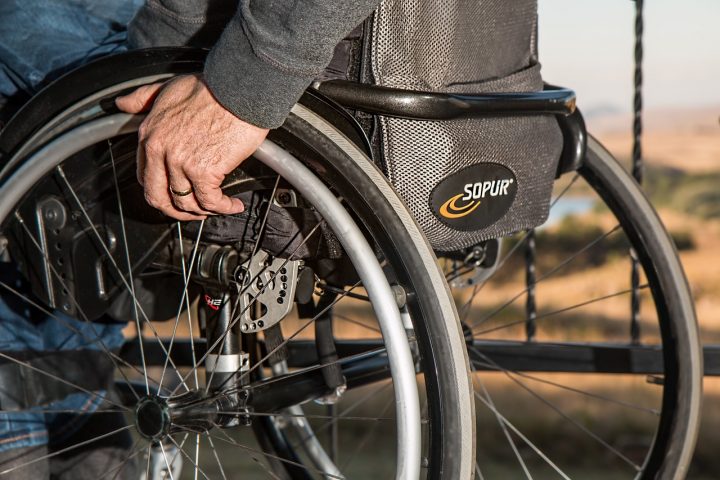Science suffers when STEM students with disabilities leave the field
Posted on: , Nic Lindh

Read Marks and Bayer’s piece in Scientific American online by clicking here.
Posted on: , Nic Lindh

Read Marks and Bayer’s piece in Scientific American online by clicking here.
Posted on: , Nic Lindh

By Lisa Friedman
Originally published in the July 18, 2019 edition of the New York Times
In a New York Times article published this week, Lisa Friedman reports that the Trump administration took a major step to weaken the regulation of toxic chemicals on Thursday when the Environmental Protection Agency (E.P.A.) announced that it will not ban chlorpyrifos, a pesticide linked to developmental delays in children. It has also been linked to lung cancer and Parkinson’s disease in adults.
The decision, which was made by E.P.A. administrator Andrew R. Wheeler, represents a win for the chemical industry and for farmers who have lobbied to continue using the toxic chemical despite its potential to cause serious harm.
Although the Obama administration announced in 2015 that it would ban chlorpyrifos after scientific studies produced by the E.P.A. showed the pesticide had the potential to damage brain development in children, the prohibition had not yet been carried out when, in 2017, then-E.P.A. administrator Scott Pruitt reversed Obama’s decision and provoked a wave of lawsuits.
Click here to read the article online.
Posted on: , Nic Lindh
2018 Winners
Ruderman Awards for Excellence in Reporting on Disability
FIRST PLACE
National Public Radio
Joseph Shapiro, Robert Little, Meg Anderson
Read story HERE
Overview: This NPR series examines the hidden epidemic of people with intellectual disabilities being sexually assaulted. The NPR Investigations Team spent more than a year sifting through court records and interviewing victims and family members. They found that crimes against people with intellectual disabilities often go unrecognized, unprosecuted and unpunished, leaving the abuser free to abuse again. The investigation also included a first-ever analysis of federal crime data and tracked what states are doing about the issue.
SECOND PLACE
Dallas Morning News
David McSwane, Andrew Chavez David
Read story HERE
Overview: “Pain and profit” documents the way Texas treats fragile people who rely on Medicaid, the government insurance program for the poor and disabled. With the help of whistleblowers and more than 160 public records requests, the series exposed the systemic denials of care and other abuses by companies paid to administer Medicaid. The Texas legislature held hearings on the findings and began considering new legislation to address the problems.
THIRD PLACE
ProPublica Illinois
Read story HERE
Overview: Duaa Eldeib, Sandhya Kambhampati, and Vignesh Ramachandran
The “Stuck Kids” investigation reveals that between 2015 and 2017, 21 percent of the time children spent in psychiatric hospitals in Illinois was not medically necessary. The children remained confined to hospitals because the state failed to find appropriate placements for them. Some children were stuck in psychiatric hospitals for months, despite evidence that unnecessarily prolonged hospital stays can have detrimental effects on children in terms of both their emotional well-being and their behavior.
HONORABLE MENTION
WNYC, New York public radio
Audrey Quinn, Aneri Pattani, Phoebe Wang
Listen HERE
Overview: “Aftereffect” is an eight-episode podcast that takes listeners inside the life of Arnaldo Rios Soto, a 26-year-old, non-speaking man with autism whose life was upended in 2016 when someone mistook a silver toy truck in his hand for a gun. Police arrived and ended up shooting and severely wounded Arnaldo’s aide, which set off a sequence of events that put Arnaldo’s life in a downward spiral.
OTHER NOTABLE ENTRIES
Presented in alphabetical order by title of entry
Mike Hixenbaugh, Houston Chronicle
December 5, 2017
Read HERE
Overview: Of the thousands of severely brain-injured people who are discharged to nursing homes or acute care hospitals in the U.S. each year, 40 percent are estimated to be covertly aware, or in the “minimally conscious state.” They drift between consciousness and brain death, trapped inside themselves and unable to communicate. This story takes a personal look at just one of the many people who are “alive inside,” despite appearing to be in a vegetative state.
“Schools Aren’t Preparing Students With Disabilities for Active Shooter Scenarios”
Jordan Davidson, The Mighty
March 14, 2018
Read HERE
Overview: There were more than 100 school shootings between Sandy Hook in 2012 and Parkland in early 2018, but there’s still no federal mandate for schools to hold active shooter drills. That means it’s up to individual schools to decide if — and how — to prepare students. As this article explores, modifications for students with disabilities are rarely included in these trainings.
2018 Winners
Katherine Schneider Medal
FIRST PLACE
Kaiser Health News
Christina Jewett
Read story HERE
Overview: “Nowhere to Go” shows how teenagers and young adults with autism are spending weeks or even months in hospitals, where they are sedated, restrained or confined to mesh-tented beds. These young people are taken to hospitals when families can’t get help from community social services and other programs; they end up calling 911, and those calls often result in long and agonizing hospital stays for their loved ones.
SECOND PLACE
KING Television in Seattle, Washington
Susannah Frame, Taylor Mirfendereski, Ryan Coe
Watch HERE
Overview: “Back of the Class” documents how thousands of children in the state of Washington are segregated in public schools, in violation of federal and state laws and despite research that shows children with disabilities made better progress in integrated classrooms. Children with disabilities are isolated from other students in classroom settings and even in the lunchroom, often as a way to save money, the report concludes, and Washington State has one of the worst records in the country in serving such children.
THIRD PLACE
“Trapped” Better Government Association and WBEZ Chicago Public Media
Alejandra Cancino, Better Government Association
Odette Yousef, WBEZ Chicago Public Media
Read story HERE
Overview: “Trapped” exposes unsafe elevators, shoddy record keeping and failed oversight at the Chicago Housing Authority, where many elderly tenants live, as the series put it, “in fear of their own buildings.” Hundreds of these residents, for whom stairs are not an option, end up trapped inside unsafe elevators in high-rise apartment buildings owned by the housing authority. The problems continue despite repeated citations for safety violations, flunked safety inspections and hundreds of panicked calls to 911. The series prompted the housing authority to begin a $25 million project to modernize and replace elevators.
HONORABLE MENTION
New Mobility Magazine
Kenny Salvini
Read story HERE
Overview: “Flying the Unfriendly Skies” relates how, in the course of a single year, the author’s wheelchair was damaged two times by two different airlines.“ Once is a case of bad luck. Twice is the universe revealing your path. Having two wheelchairs destroyed by two different airlines in the span of a year has a way of thrusting you into a bit of reluctant advocacy with a lot of questions that need answers,” Salvini writes. He set out to find the answers and discovered a history of failed airline policies and a seeming indifference that affects thousands of others who live with disabilities.
NOTABLE ENTRY
Todd Wiseman, Texas Tribune
April 23, 2018
Watch HERE
Overview: This video documentary follows two Texas families as they begin their journey to pursuing an alternative form of medical treatment for children with epilepsy: cannabis oil, or CBD oil. Despite the state’s passage of the Compassionate Use Act in 2015, which legalized a certain type of CBD oil for epilepsy patients who haven’t responded to federally-approved medication, families still face challenges with getting the treatment.
Posted on: , Nic Lindh
Despite the passage of the ADA and accessibility lawsuits filed against Wells Fargo, Morgan Stanley, and other prominent investment management services, people with disabilities encounter frustrating obstacles in the banking world. Inaccessible websites and other digital barriers impede the efforts of those with disabilities to do even the most mundane tasks, such as check an account balance or read credit statements at the end of the month.

So Mr. Rizzi, 55, the founder of My Blind Spot, an accessibility advocacy group in New York, filed a federal lawsuit in April 2018 against Morgan Stanley, the firm he uses to manage his personal retirement accounts.
Mr. Rizzi’s suit accused the bank of violating the Americans With Disabilities Act by “denying access to its websites to individuals with disabilities who are visually impaired” and who require screen-reader software to access digital content. Mr. Rizzi also cited the bank for not having an accessibility website or hotline. The case, which sought about $9 million in damages, was settled last summer, his lawyer, Lambros Lambrou, said.
In a separate case, Wells Fargo in 2011 settled an investigation by the Justice Department alleging ADA violations because the bank failed to accept what is known as video relay services, or video phone calls, from deaf customers. The settlement required the bank to pay $16 million to some account holders and remedy a variety of accessibility problems.
Click here to read Joshua Brockman’s article in the July 5, 2019 edition of the New York Times.
Posted on: , Nic Lindh

In addition to highlighting the need for better home-care services in the state, the Phoenix Magazine article also highlights Arizona’s failure to investigate the state’s Division of Developmental Disabilities, despite there being scores of formal complaints and well-documented concerns regarding the poor quality of the DDD’s in-home nursing services.
Click here to read Amy Silverman’s Phoenix Magazine article online.
Posted on: , Nic Lindh

More than 1 in 4 people living in the United States has a mental or physical disability, according to a 2018 report from the Census Bureau, which collected the data in 2014.
Media reports, however, hardly reflect the fact that 27.2% — or 85.3 million people — nationwide are living with disabilities. Stories about people with disabilities often fall into two broad categories, says Kristin Gilger, who is director of the National Center on Disability and Journalism (NCDJ) and the associate dean of the Walter Cronkite School of Journalism and Mass Communication at Arizona State University.
The first category is what Gilger calls “inspiration porn” — stories about people with disabilities throwing the winning pass for the high school football team or being named prom queen, for example. “It’s well-intentioned, but those stories also can be very exploitative and they are very limited in really getting to the heart of how people live and what they think and how they’re affected by what’s going on in our civic life,” she says.
The second category consists of crime stories, which sometimes mention mental illness — a narrow slice of the kind of coverage the subject deserves. “We still have some work to do in the range and sophistication of [mental illness] coverage,” Gilger says.
Gilger says the lack of disability coverage might stem from a lack of representation in newsrooms. “We haven’t done a very good job of hiring people particularly with physical disabilities, who might need some kind of accommodation in the workplace — people who use wheelchairs, for example, or have hearing or vision limitations or any number of other things,” Gilger notes. “If you don’t have those people in your newsroom, you’re not likely to do a very good job of understanding and pursuing stories that are relevant to those populations … If you’re not comfortable with the coverage area, you just don’t know enough about it, it’s not likely that you’re going to pursue it.”
Amy Silverman, a journalist and NCDJ board member who, in 2018, updated the center’s Disability Language Style Guide, echoes Gilger’s sentiment. “I think that disability is really intimidating to people,” she says. “First of all, because they don’t want to say the wrong thing. And second, because it’s something uncomfortable to think about.”
To help journalists improve their coverage of people with disabilities, we’re sharing four key tips from Gilger and Silverman.
Read the article by Chloe Reichel here.
Posted on: , Nic Lindh
[Video courtesy of EquipforEquality / YouTube]
Twenty years have passed since the Olmstead decision by the Supreme Court, which found that people with disabilities have a right to receive services outside of institutions, and to be fully integrated in their communities.
Background
The 1999 Olmstead v. L.C. decision fundamentally changed the lives of Lois Curtis and Elaine Wilson, who had both been institutionalized and living in isolation for an extended period of time after they had been voluntarily admitted into a state-run psychiatric unit for treatment. Even after mental healthcare providers approved their release, Curtis and Wilson were, essentially, stuck in the institution.
The Case
In a first-of-its-kind use of the ADA–which was less than a decade old–Curtis and Wilson filed a lawsuit. The result was a landmark decision by the Supreme Court, which found that confining individuals “greatly diminishes the everyday life activities of individuals, including family relations, social contacts, work options, economic independence, educational advancement, and cultural enrichment.”
Olmstead Impact
Since the Olmstead decision in 1999, many people have been freed from institutions and have a legal right to live where they want to live.
Listen to Ruth Bader Ginsburg deliver the majority opinion for the court:
Posted on: , Nic Lindh

Job listings that discourage people with disabilities from applying are prevalent across professional industries, from journalism and news media to finance and higher education. Not only do these job descriptions discourage candidates with disabilities from applying to jobs for which they are qualified, but they also exacerbate the larger problem of people with disabilities being underemployed in full-time work.
Kristin Gilger, a senior associate dean at the Cronkite School and our director here at the NCDJ, is quoted in a recent HuffPost article discussing why these job descriptions are problematic and how they can be changed to attract a more diverse pool of candidates. The article was written by Wendy Lu, a journalist and disability rights advocate.
Click here to read Lu’s article on disability discrimination in the workplace.
Posted on: , Nic Lindh

Adam Schmuki, a linguistics graduate student at Arizona State University, studies the language and narratives people use on Twitter to refer to disability. A wheelchair user himself, Schmuki became interested in the subject earlier this year when he came across the hashtag #AbledsAreWeird. The hashtag gained popularity among Twitter’s disability community in late March as a way to normalize people with disabilities, who are often regarded by outsiders as “other.”
Click here to read more about Adam Schmuki’s research on language used to discuss disability on Twitter.
Curious to learn more about disability and language? Check out our disability language style guide, which is available in both English and Spanish.
Posted on: , Nic Lindh
After a recent legislative session ended at 2 a.m., Rep. Jennifer Longdon, D-Phoenix, a wheelchair user and NCDJ board member, had no choice but to roll 1.5 miles home from the Capitol. Longdon’s difficulty getting home illustrates the lack of accessible public transit options in Phoenix. How can people who rely on public transportation be productive or work late, if needed, in a city that doesn’t have a 24-hour bus system?
Several colleagues and a police officer accompanied Longdon on her roll home, but, as Longdon pointed out, many people with disabilities wouldn’t be able to access the kind of help that she [as an elected state representative] could.
Click here to read more about this news story in the Arizona Republic.
Above: Rep. Jennifer Longdon thanks Phoenix police and tells her colleagues about her travails getting home on May 24, 2019. (Video: Robbie Sherwood / azcentral.com)